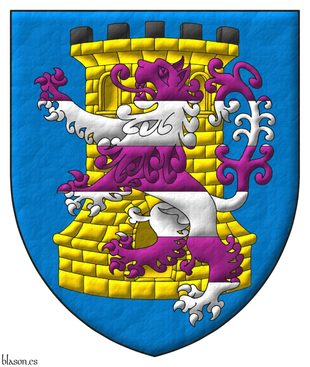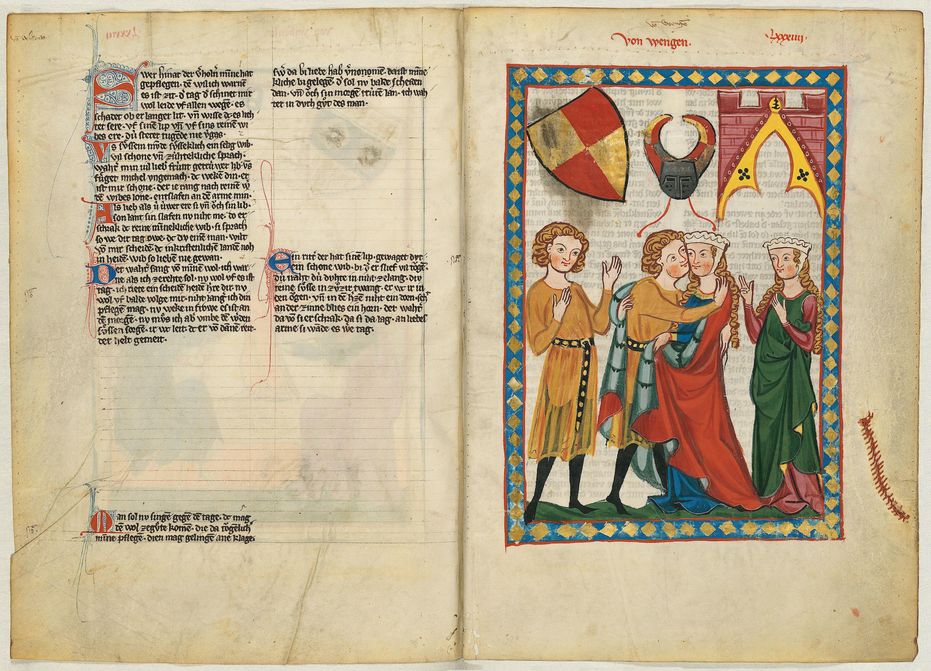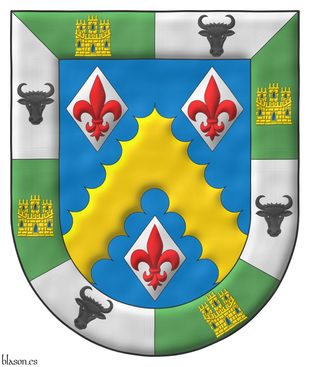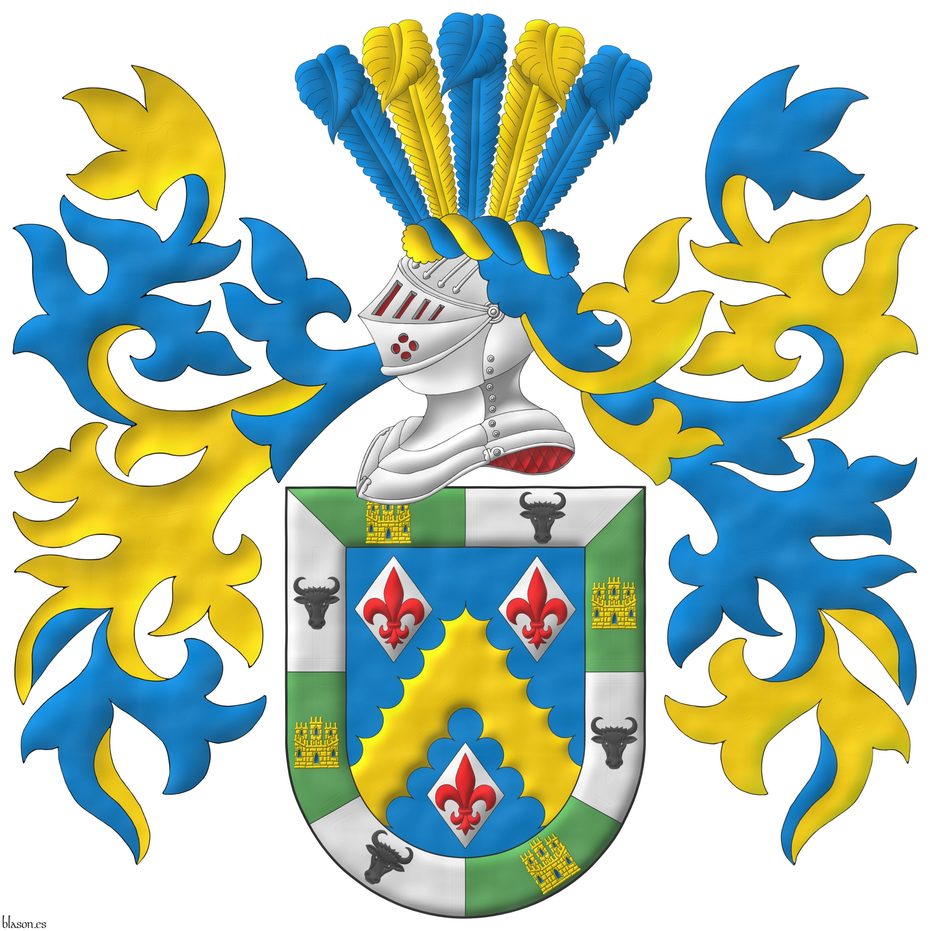
Jean Mortés, plain tincture
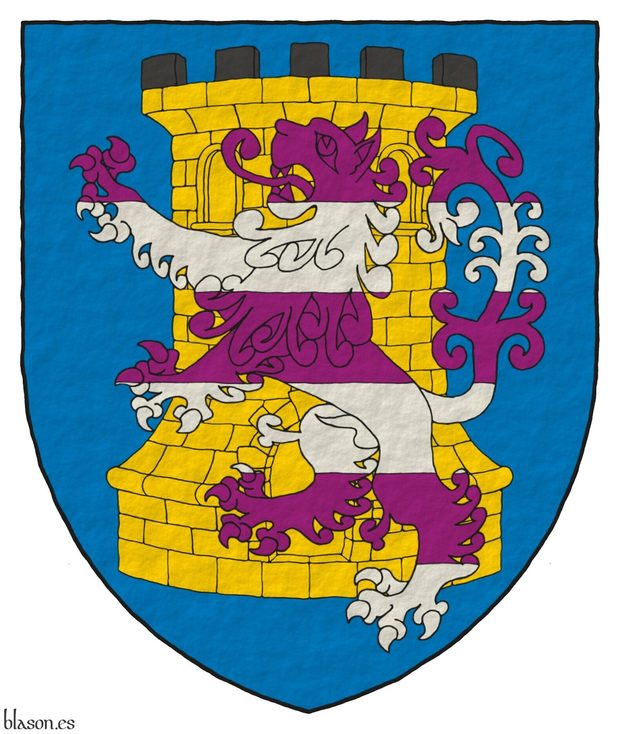
Azure, a tower Or, embattled and masoned Sable, overall a lion rampant barry Purpure and Argent.
Arms interpreted by me, in plain tinctures, contoured in Sable, and with a texturized finishing.
Coat of arms of Jean Mortes from Brittany, France, emblazoned by me.
Blazon keywords: Azure, Or, Sable, Argent, Purpure, One, Tower, Embattled, Masoned, Overall, Lion, Rampant and Barry.
Style keywords: Outlined in sable and Plain tincture.
Classification: Personal, Interpreted, Boa and Coat of arms.
Bearer: Mortés, Jean.


Jean Mortés, structured and parallel blazons
Coat of arms of Jean Mortes from Brittany, France, emblazoned by me with a heater shape, and with the blazon written in English and Castilian in a structured way to observe the parallelism between both forms.
Blazon keywords: Azure, Or, Sable, Argent, Purpure, One, Tower, Embattled, Masoned, Overall, Lion, Rampant and Barry.
Style keywords: Outlined in sable, Illuminated, Pointed and Leather.
Classification: Personal, Interpreted, Structured and parallel blazons, Boa and Coat of arms.
Bearer: Mortés, Jean.


![Ver [Manesse; 1315] en referencias bibliográficas. Libro abierto, hojas de plata, filo de oro, guardas de gules, tapas de sable.](../css/Libro.Bibliografia.png)
Manesse; 1315
Anonymous, «Große Heidelberger Liederhandschrift», University Library of Heidelberg, call number Codex Palatinus Germanicus 848, 852 pages, numbered from folio 1 to folio 426 v and r each side, parchment, 35.5 x 25 centimeters, manuscript in Middle High German, circa 1300-1340.
Von Wengen, folio 300r
Contents
The «Codex Manesse», also known as the «Great Heidelberg Book of Songs», Codex Palatinus Germanicus 848, is the most comprehensive collection of ballads and epigrammatic poetry in Middle High German. The manuscript contains almost 6000 verses from 140 poets, making it a key source for medieval German lyrics. The manuscript is written in gothic letters by several hands and is famous for its glorious colorful full-page miniatures, each dedicated to one of the 137 poets. The miniatures illustrate the poets in idealized, courtly scenes and are considered a significant document of Gothic illumination from the Upper Rhine region. It is not an armorial, but some of the illustrations feature coats of arms, including helmets with their crests.
The Manesse family
This codex was completed around the year 1304, although some parts may have been added later, up until the mid-14th century. Therefore, an approximate date of 1315 is often used as a general reference for the codex in its most complete state. The author of the codex is not known in the modern sense of the word. However, its compilation and sponsorship are attributed to the Manesse family, a patrician family from Zurich, particularly Rudolf II Manesse and his son Rudolf III Manesse, who likely commissioned and financed the creation of the codex.
Ownership history
The early history of the manuscript is not well-documented, by the end of the 16th century, it was in the possession of the Swiss Calvinist Johann Philipp von Hohensax. In 1607, the codex was claimed by the Prince Elector Frederick IV and brought to Heidelberg. During the Thirty Years' War, the manuscript was taken into exile to avoid capture. After the death of Frederick V in 1632, the manuscript was auctioned and eventually found its way to the Royal Library in Paris, where it remained for 230 years. In 1888, the manuscript was returned to Germany after a complex exchange deal orchestrated by bookseller Karl Ignaz Trübner. It is now preserved in the University Library of Heidelberg.
Condition and preservation
The turbulent history of the «Codex Manesse» has left its mark, with many miniatures showing damage from color abrasions and ink corrosion. Due to its fragile condition, the original codex is kept in an air-conditioned safe and is rarely exhibited. Facsimile editions have been produced over the years, including a full-facsimile published by Insel Verlag in 1925-1927.
Exhibitions and legacy
The «Codex Manesse» has been the subject of numerous exhibitions, including a comprehensive display in 1988 and another during the 625th anniversary of the University of Heidelberg in 2010-2011. It remains one of the most precious treasures of the University Library of Heidelberg and a cornerstone in the study of medieval German literature and art.
Bibliographical reference of century XIV.
Classification: Manuscript, German language and In color.
Author: anonymous.
External links:
Internal resources: Manesse1315.pdf Armorial in PDF format.


Jose Manuel Gutiérrez Benítez, plain tincture
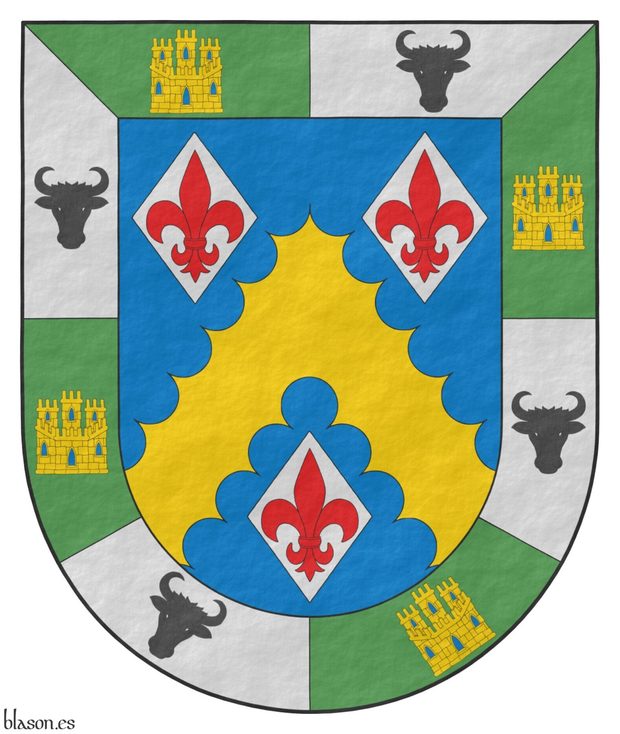
Azure, a chevron engrailed Or between three lozenges Argent, each charged with a fleur de lis Gules; a bordure compony of eight sections, four Vert each charged with a castle triple-towered Or, port and windows Azure, masoned Sable, and four Argent each charged with a bull's head caboshed Sable.
Arms designed by me, in flat tinctures, contoured in Sable, with a semi-circular outer contour and with a texturized finish.
This is the coat of arms of Jose Manuel Gutierrez Benitez designed by him and me and emblazoned by me.
Blazon keywords: Azure, Or, Argent, Gules, Vert, Sable, One, Three, Four, Eight, Chevron, Engrailed, Lozenge, Fleur de lis, Bordure, Compony, Castle, Triple-towered, Port and windows, Masoned, Bull, Head and Caboshed.
Style keywords: Outlined in sable, Plain tincture and Semi-circular.
Classification: Personal, Created, Boa and Coat of arms.
Bearer: Gutiérrez Benítez, Jose Manuel.


Gutiérrez Benítez, Jose Manuel
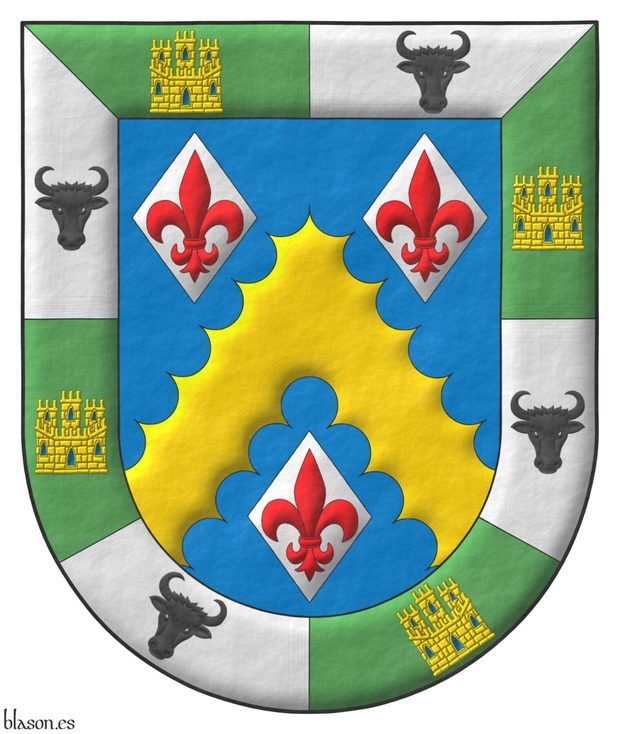
Azure, a chevron engrailed Or between three lozenges Argent, each charged with a fleur de lis Gules; a bordure compony of eight sections, four Vert each charged with a castle triple-towered Or, port and windows Azure, masoned Sable, and four Argent each charged with a bull's head caboshed Sable.
Escudo de azur, un cabrio angrelado de oro acompañado de tres losanges de plata, cada uno cargado de una flor de lis de gules; una bordura componada de ocho compones, cuatro de sinople, cargados cada uno de un castillo de oro, aclarado de azur, mazonado de sable, y cuatro de plata, cargados cada uno de un rencuentro de toro de sable.
Arms devised by me, illuminated with lights and shadows, contoured in Sable, with a semi-circular outer contour and with a rough finish.
This is the coat of arms of Jose Manuel Gutierrez Benitez designed by him and me and emblazoned by me.
Blazon keywords: Azure, Or, Argent, Gules, Vert, Sable, One, Three, Four, Eight, Chevron, Engrailed, Lozenge, Fleur de lis, Bordure, Compony, Castle, Triple-towered, Port and windows, Masoned, Bull, Head and Caboshed.
Style keywords: Outlined in sable, Illuminated, Semi-circular and Rough.
Classification: Personal, Created, Boa and Coat of arms.
Bearer: Gutiérrez Benítez, Jose Manuel.


Jose Manuel Gutiérrez Benítez, structured and parallel blazons
This is the coat of arms of Jose Manuel Gutierrez Benitez designed by him and me and emblazoned by me, with the blazon written in English and Castilian in a structured way to observe the parallelism between both forms.
Blazon keywords: Azure, Or, Argent, Gules, Vert, Sable, One, Three, Four, Eight, Chevron, Engrailed, Lozenge, Fleur de lis, Bordure, Compony, Castle, Triple-towered, Port and windows, Masoned, Bull, Head and Caboshed.
Style keywords: Outlined in sable, Illuminated, Semi-circular and Watercolor.
Classification: Personal, Created, Structured and parallel blazons, Boa and Coat of arms.
Bearer: Gutiérrez Benítez, Jose Manuel.


Jose Manuel Gutiérrez Benítez
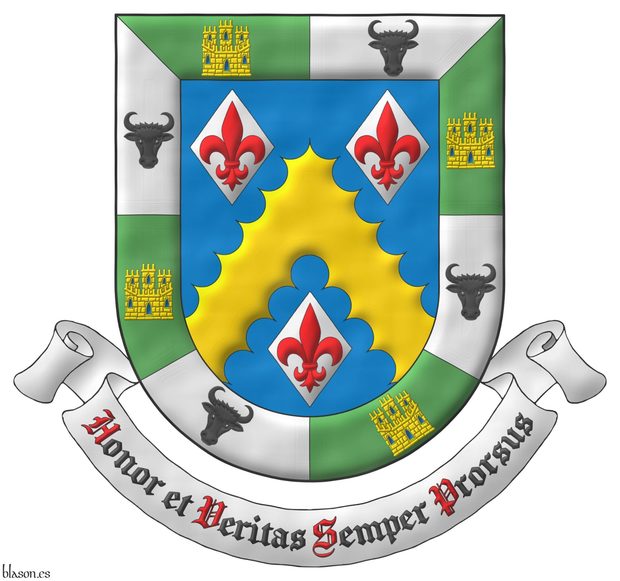
Azure, a chevron engrailed Or between three lozenges Argent, each charged with a fleur de lis Gules; a bordure compony of eight sections, four Vert each charged with a castle triple-towered Or, port and windows Azure, masoned Sable, and four Argent each charged with a bull's head caboshed Sable. Motto: «Honor et Veritas Semper Prorsus» Sable, with initial letters Gules, over a scroll Argent.
Escudo de azur, un cabrio angrelado de oro acompañado de tres losanges de plata, cada uno cargado de una flor de lis de gules; una bordura componada de ocho compones, cuatro de sinople, cargados cada uno de un castillo de oro, aclarado de azur, mazonado de sable, y cuatro de plata, cargados cada uno de un rencuentro de toro de sable. Lema: «Honor et Veritas Semper Prorsus» de sable, con letras iniciales de gules, sobre una filacteria de plata.
Arms designed by me, illuminated with lights and shadows, contoured in Sable, with a semi-circular outer contour and with a watercolor finish.
Design rationale
In Spanish heraldry, the use of bordures is often a matter of personal preference, in this case, the tinctures and charges on this bordure compony are a proud emblem of the bearer's origins from Utrera, Seville, the white represents the local architecture, the green symbolizes the olive groves, and the bull's head denotes Utrera as the cradle of the brave bull, a reference, along with the castle, to the arms of his town. The Latin motto tells us, «Honor and Truth Always at the Forefront».
Blazon keywords: Azure, Or, Argent, Gules, Vert, Sable, One, Three, Four, Eight, Chevron, Engrailed, Lozenge, Fleur de lis, Bordure, Compony, Castle, Triple-towered, Port and windows, Masoned, Bull, Head, Caboshed and Motto.
Style keywords: Outlined in sable, Illuminated, Semi-circular and Watercolor.
Classification: Personal, Created, Design rationale, Boa and Coat of arms.
Bearer: Gutiérrez Benítez, Jose Manuel.


Crest and mantling of Jose Manuel Gutiérrez Benítez
Azure, a chevron engrailed Or between three lozenges Argent, each charged with a fleur de lis Gules; a bordure compony of eight sections, four Vert each charged with a castle triple-towered Or, port and windows Azure, masoned Sable, and four Argent each charged with a bull's head caboshed Sable. Crest: Upon a helm lined Gules, with a wreath Or and Azure, five ostrich feathers, alternately three Azure and two Or. Mantling: Azure doubled Or.
Arms designed by me, illuminated with lights and shadows, contoured in Sable, with a semi-circular outer contour and with a watercolor finishing.
Blazon keywords: Azure, Or, Argent, Gules, Vert, Sable, One, Two, Three, Four, Five, Eight, Chevron, Engrailed, Lozenge, Fleur de lis, Bordure, Compony, Castle, Triple-towered, Port and windows, Masoned, Bull, Head, Caboshed, Crest and mantling, Crest, Upon (wreath), Helm, Lined, Wreath, Ostrich feathers, Alternately and Mantling.
Style keywords: Outlined in sable, Illuminated, Semi-circular and Watercolor.
Classification: Personal, Created, Boa and Coat of arms.
Bearer: Gutiérrez Benítez, Jose Manuel.

Continue with: Crest, mantling and motto of Jose Manuel Gutiérrez Benítez.
-
Language
-
Categories of heraldry
-
Divisions of the field
- Without divisions
- Party per pale
- Party per fess
- Party per bend
- Party per bend sinister
- Tierce
- Tierce sinister
- Tierced per pale
- Tierced per fess
- Tierced per bend
- Tierced pallwise inverted
- Quarterly
- Quarterly per saltire
- Gyronny
- Party per fess, the chief per pale
- Party per pale, the sinister per fess
- Party per fess, the base per pale
- Party per pale, the dexter per fess
- Chapé
- Chaussé
- Embrassé
- Contre-embrassé
- Party per chevron
- Enté
- Enté en point
- Flanched
-
Metals
-
Colours
-
Furs
-
Other tinctures
-
Ordinaries and sub-ordinaries
-
Diminutives of the ordinaries
-
Geometric charges
-
Composite ordinaries
-
Inanimate charges from Nature
Atom, Crescent, Diamond, Emerald, Estoile, Increscent, Lightning flash, Moon, Mount, Mullet, Mullet of four points, Orbital, Plough of Ursa Major, Rainbow, Ray of the sun, River, Sea, Snowflake, Sun, Sun in splendour, Sun of May, Trimount, Water and Wave.
-
Vegetal charges from Nature
Acorn, Apple, Apple tree, Ash, Bluebonnet, Camellia, Chrysanthemum, Cinquefoil, Cornflower, Dogwood flower, Double rose, Elm, Fleur de lis, Flower, Gourd, Holm oak, Hop cone, Kapok tree, Laurel, Lily, Linden, Lotus flower, Madonna lily, Mexican cedar tree, Oak, Olive tree, Palm tree, Plantain plant, Pomegranate, Poplar leaf, Rose, Shamrock, Sunflower, Thistle, Tree, Tulip, Vine and Wheat.
-
Animal charges from Nature
Badger, Bald eagle, Barbel, Barn owl, Bear, Beaver, Beetle, Bighorn sheep, Blackbird, Boar, Brach hound, Bull, Doe, Dog, Dolphin, Dove, Eagle, Elephant, Falcon, Female figure, Fish, Flame, Fly, Fox, Frog, Goat, Goldfinch, Goose, Heron, Horse, Hummingbird, Jaguar, Lark, Leopard, Lion, Lion passant, Lion rampant guardant, Lioness, Lynx, Male figure, Martlet, Merino ram, Owl, Panther, Parrot, Peacock, Pelican, Pelican in her piety, Puffin, Quetzal, Raven, Roe deer, Rooster, Savage, Seagull, Serpent, She-wolf, Stag, Starling, Talbot, Tyger, Vulture, Warren hound and Wolf.
-
Parts of natural charges
Arm, Beak, Branch, Caboshed, Chest, Claw, Covert, Dorsal fin, Eagle claw, Ermine spot, Escallop, Feather, Foot (palmiped), Foreleg, Forepaw, Hand, Head, Heart, Hoof, Leaf, Neck, Ostrich feather, Palm frond, Paw, Roe deers' attires, Shoulder, Sprig, Stags' attires, Stem, Swallow-tail, Tail, Tail addorsed, Tail fin, Talon, Tooth, Trunk, Trunk (elephant), Two hands clasped, Two wings in vol, Udder, Wheat spike, Wing and Wrist.
-
Artificial charges
Ace of spades, Anchor, Anvil, Arch, Arm vambraced, Armillary sphere, Arrow, Axe, Bell, Bell tower, Beret, Bonfire, Book, Bookmark, Bow, Branding iron, Bridge, Broken, Buckle, Cannon, Cannon dismounted, Cannon port, Canopy roof, Carbuncle, Castle, Celtic Trinity knot, Chain, Chess rooks, Church, Clarion, Clay pot, Closed book, Club, Column, Comb, Compass rose, Conductor's baton, Cord, Covered cup, Crozier, Crucible, Cuffed, Cup, Cyclamor, Dagger, Double vajra, Drum, Ecclesiastical cap, Fanon, Federschwert, Fleam, Four crescents joined millsailwise, Galician granary, Garb, Gauntlet, Geometric solid, Grenade, Halberd, Hammer, Harp, Host, Hourglass, Key, Key ward, Knight, Knot, Lantern, Letter, Line, Loincloth, Menorah, Millrind, Millstone, Millwheel, Monstrance, Mortar, Mullet of six points pierced, Nail, Non-classic artifact, Norman ship, Number, Oar, Oil lamp, Open book, Page, Pair of scales, Parchment, Pestle, Piano, Pilgrim's staff, Plough share, Polish winged hussar, Port, Portcullis, Potent, Quill, Ribbon, Rosette of acanthus leaves, Sabre, Sackbut, Sail, Scroll, Scythe, Sheaf of tobacco, Ship, Skirt, Spear, Spear's head, Stairway, Star of David, Step, Sword, Symbol, Tetrahedron, Torch, Tower, Trident, Trumpet, Turret, Two-handed sword, Wagon-wheel, Water-bouget, Wheel, Winnowing fan and With a turret.
-
Immaterial charges
Angel, Archangel, Basilisk, Dragon, Dragon's head, Garuda, Golden fleece, Griffin, Heart enflamed, Justice, Mermaid, Our Lady of Mercy, Ouroboros, Paschal lamb, Pegasus, Phoenix, Sacred Heart of Jesus, Saint George, Sea-griffin, Trinity, Triton, Unicorn, Winged hand and Wyvern.
-
External elements
-
Heraldic creations
-
References
-
Formats
-
Keywords on this page
Port and windows, Watercolor, Embattled, Alternately, Engrailed, Azure, Structured and parallel blazons, Boa, Bordure, Overall, Wreath, Head, Chevron, Castle, Upon (wreath), Crest, Five, Compony, Created, Four, Triple-towered, Outlined in sable, Two, Coat of arms, Barry, Fleur de lis, Lined, Personal, Gules, Gutiérrez Benítez, Jose Manuel, Illuminated, Interpreted, Mantling, Motto, Lion, Lozenge, Masoned, Semi-circular, Mortés, Jean, Eight, Or, Ostrich feathers, Argent, Caboshed, Sable, Vert, Bull, Three and One.

